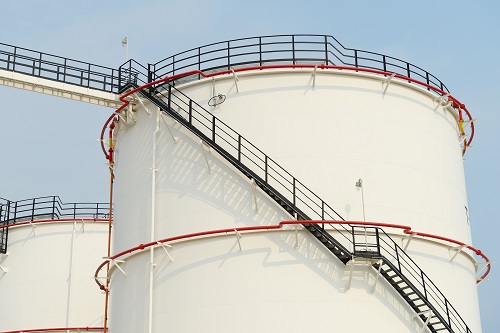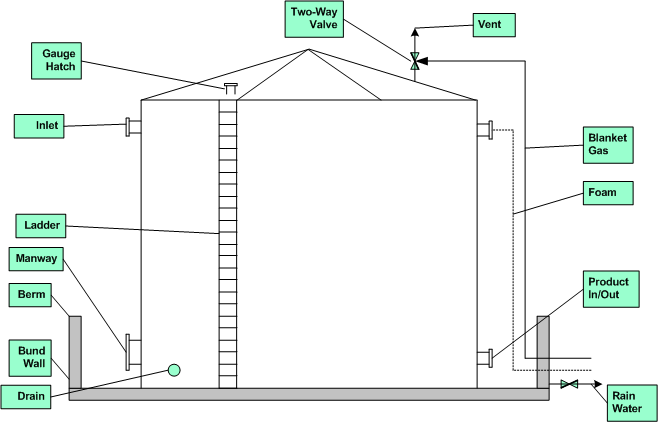Safety Moment #73: Storage Tanks in the Process and Energy Industries

September 2022
OSHA has opened the Process Safety standard for comment and revision. One of the items on their list is to do with storage tanks. Item II.1 reads,
Clarifying the exemption for atmospheric storage tanks
Some thoughts as to what direction this statement may take are provided in the post Update to OSHA's PSM Regulation. Part 4: Atmospheric Storage Tanks.
**************************
Storage tanks are widely used in the process industries to store liquids that are below their boiling point at atmospheric temperature (some tanks may be insulated and they may have heating or cooling coils to maintain the temperature of the liquid that they are storing). Typically, tanks are either open to the atmosphere or to a system such as a flare or vent header that is at atmospheric pressure (this does not apply to floating roof tanks). Unlike pressure vessels, storage tanks cannot handle either high pressure or vacuum conditions.
This Safety Moment provides guidance to do with the design and operation of storage tanks; information to do with their layout is provided at Safety Moment #89: Layout of Process Facilities.
Uses of Storage Tanks
Broadly speaking, storage tanks fall into one of three categories: without a roof, with a fixed roof and with a floating roof. Tanks without a roof are unusual in the process industries because the contents are usually flammable or toxic and so must be contained. Also it is usually important that the liquid in the tank not be contaminated. However some tanks, such as those used for storing cooling water, may not need a roof. Before discussing the design and operation of storage tanks it is useful to review why they are needed.
The first, and most obvious role, of a storage tank is that it is a "wide spot in the line". For example, a facility may produce a steady stream of liquid product but the barges needed to remove that product and take it to market are not always present. So some means of storing accumulation is needed. (The same argument applies in reverse - large shipments may arrive in batches so the material has to be stored in tanks from which the liquid is pumped into the process at a steady rate.) Within the process itself intermediate storage tanks serve a similar purpose; they help smooth out the different flow rates of liquids between the various operating units.
A second role of storage tanks is to allow for product to be tested before it is shipped to the customer. Once the tank is full it can be sealed off from further input. Then the quality experts from both the supplier and the customer side can sample and analyze the contents of the tank before releasing it.
Tanks can also be used for blending. If the liquid in one tank has, say, too high a concentration of light ends materials then liquid from other tanks that has a lower concentration can be blended in to make sure that the product is acceptable to the customer.
From an economic point of view storage tanks represent a cost and their use should be minimized where possible. The costs include the following.
Capital
Not only do the tanks themselves require a substantial investment, they generally need substantial amounts of costly real estate.
Operating Expense
Although they do not generally use many utilities such as steam or hot oil, tanks do have an operating cost to do with filling and emptying, and they require a commitment of operations and maintenance personnel.
Inventory Cost
Product sitting in a tank is not generating revenue.
Principles of Design and Operation
Shown below is a sketch of a typical fixed roof tank. It illustrates many of the principles to do with the design and operation of all types of tank.

- The tank is located inside a bund wall that retains any liquids that may spill. The wall has a drain to remove accumulated rainwater. The bund will generally have a capacity equal to 110% of the largest single tank in the tank farm being protected.
- A connection is provided so that foam can be injected on to the top of the tank so that foam can be applied for fire control.
- The tank is provided with at least one manway so that maintenance personnel can enter it (once it has been thoroughly purged of flammable and toxic vapors).
- There is a drain at the bottom of the tank. This will be used for removing sludge (BS&W) from the tank. It will also be used to remove water in the tank at the conclusion of maintenance work.
- A single connection is generally used for adding and removing the products to the tank.
- The sketch shows an inlet connection at the top of the tank. This may not be needed. If it is used it is important to make sure that the entering liquids do not splash because they may create a static charge.
- At the top of the tank is a small gauge hatch (sometimes referred to as a dip or thief hatch). Assuming it is safe to do so, an operator can use the hatch to measure the level of liquid in the tank with a strapping gauge.
- A ladder on the side of the tank is used for access to the roof and the gauge hatch.
- There is a guard rail around the top of the tank. (In some cases the rail may only be provided in the location of the gauge hatch.)
- The two-way valve allows gases to be vented to a safe location when the gas is being filled and blanket gas to be added when the tank is being emptied. If it is safe to have air present inside the tank then this valve can be a simple vent to and from the atmosphere.
Further Information
The book Plant Design and Operations provides additional guidance to do with the design and operation of storage tanks.
Chapter 3 - Equipment and Buildings
Functions of Storage Tanks
Types of Storage Tank
Fixed Roof Tanks
Floating Roof Tanks
Plastic Tanks
Bund Walls / Berms
Tank Farms
Stairs and Platforms
Tank Design
Static Electricity
Blanket / Padding Gas
Vents
Connections, Nozzles, Manways
Overflow Systems
Instrumentation
Temperature Control
Tank Fires
Boilover / Foamover
Rag Layers
BS&W
Chapter 8 - Operations
Filling and Emptying
Purging and Cleaning
You are welcome to use this Safety Moment in your workplace. But please read Use of Safety Moments.
Copyright © Ian Sutton. 2020. All Rights Reserved.
